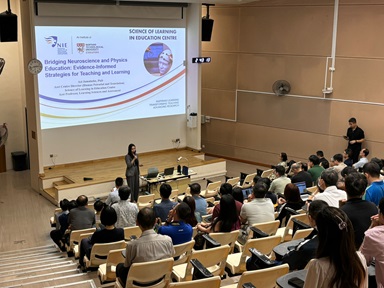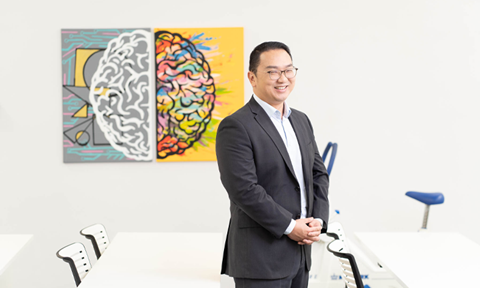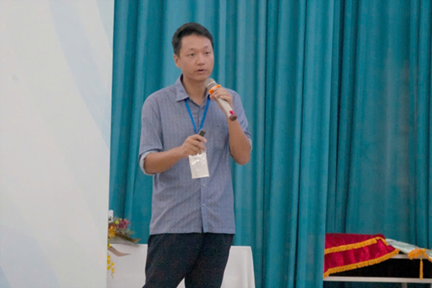Prof Tan Oon Seng speaks on Singapore’s emphasis on importance of learners having strong fundamentals to become adaptive for future learning.
Prof Tan Oon Seng, Centre Director of the Centre for Research in Child Development (CRCD), was invited to speak at Organisation for Economic Co-operation and Development's (OECD) Education and Skills (E2030) Math Pedagogies International Workshop 2022 on 23 March 2022. Titled 'Mathematics Curriculum, Values and Textbooks: A Singapore approach', Prof Tan spoke on how Singapore emphasises the importance of learners having strong fundamentals to become adaptive for future learning. The goal of education in Singapore is to equip students with the basic knowledge and analytical skills to move up the value-chain and be competitive in a globalised knowledge-based economy. Strong fundamentals ensure application of knowledge and skills in unfamiliar real-life situations. According to PISA findings, Singapore’s experience demonstrates that students:
- Possess strong fundamentals
- Are adept at applying knowledge and skills in solving novel real-life problems
- Can navigate in computer-based environments, work with less structured data, interact and uncover relationships
Given these findings, there is buzz about Singapore mathematics, and education stakeholders around the world want to understand how Singapore is so successful in teaching mathematics. Prof Tan shared his recent publication titled 'Singapore Math and Science Education Innovation: Beyond PISA' (Tan et al, 2021) explains how Singapore’s emphasis on values and attitudes in the curriculum, pedagogy and textbooks contributes to students’ positive learning experiences and appreciation of subject content. For example, teachers use things they observe in the world to help teach the content, such as a tree or a structure; and they approach the subject with a simple underpinning principle which is that mathematics is a study of patterns. When students hear that the study of mathematics is about studying patterns, they are not frightened because it refers to something pictorial and is an idea they can understand. Singapore makes mathematics textbooks very pictorial because they want students to be able to look for patterns and have an appreciation for them. Over the past 20-30 years, there has been a shift in Singapore’s curriculum from focusing on skills and concepts to attitudes, metacognition and processes. This shift can be seen across textbook development as well.
Prof Tan told international participants that the importance of problem-solving in mathematics cannot be ignored, and that this aspect of the subject is invariant. Since the 1980s, Singapore has not changed its fundamental approach to mathematics. As Singapore’s mathematics textbooks evolved from the late 1980s to the 1990s, the problem-solving approach remained constant, aiming to help students become better thinkers and more effective problem-solvers by using four basic steps:
- Step 1: Understand the problem
- Step 2: Decide on a plan
- Step 3: Carry out the plan
- Step 4: Look back (Reflect)
To this day, Singapore emphasises the thinking in mathematics, e.g. with pictorials to reinforce that thinking is happening. Pictorials can help simplify things, and Singapore employs a variety of visuals to help students understand a problem, such as drawings and patterns. When presented with a problem in a textbook, students are encouraged to use strategies to decide on a plan for solving the problem, such as considering a simpler problem, using trial and error, or looking for a pattern.
After having carried out the plan and obtaining the solution of a problem by a particular method, students are encouraged to check the solution and consider why it is solved in that way. They are also encouraged to consider whether there is more than one possible solution. Important questions to ask when looking back on work include:
- How can I check the solution?
- Is there more than one possible solution?
- Is there another way of solving the problem?
- Can I find a general formula for the result?
- Can I explore related problems?
Underpinning the textbooks, which are alive with visuals and experiential learning, Singapore’s curriculum takes into account students’ phases of learning – readiness, engagement and mastery – as well as harnesses multisensory tools and technology to strengthen visualisation, simulations and representation and to support exploration and experimentation. Students remain engaged in learning thanks in part to the curriculum framework’s core emphasis on values, including beliefs, interest, appreciation, confidence and perseverance. Ultimately, by aligning the curriculum, textbooks and pedagogy, Singapore helps teachers to help students feel mathematics and enjoy the learning.







